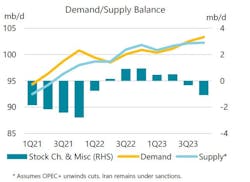IEA raises oil demand growth forecasts by 380,000 b/d
In its August Oil Market Report (OMR), the International Energy Agency (IEA) raised its estimates for 2022 global demand growth by 380,000 b/d, to 2.1 million b/d, as soaring oil use for power generation and gas-to-oil switching are boosting demand. Gains mask relative weakness in other sectors, and a slowdown in growth to less than 100,000 b/d by fourth-quarter 2022 from 5.1 million b/d at the start of the year. World oil demand is now forecast at 99.7 million b/d in 2022 and 101.8 million b/d in 2023.
“At the same time, natural gas and electricity prices have soared to new records, incentivizing gas-to-oil switching in some countries. With several regions experiencing blazing heatwaves, the latest data confirm increased oil burn in power generation, especially in Europe and the Middle East but also across Asia. Fuel switching is also taking place in European industry, including refining. In this report, we have revised our forecast for world oil demand higher for the remainder of the year,” IEA said.
World oil supply hit a post-pandemic high of 100.5 million b/d in July as maintenance wound down in the North Sea, Canada, and Kazakhstan. OPEC+ ramped up total oil production by 530,000 b/d in line with higher targets and non-OPEC+ rose by 870,000 b/d. World oil supply is set to rise by a further 1 million b/d by yearend.
In this report, EIA revised up its forecast for Russian oil output but lowered the outlook for North America. By July, Russian oil production was only 310,000 b/d below pre-war levels while total oil exports were down just 580,000 b/d. The EU embargo on Russian crude and product imports that comes into full effect in February 2023 is expected to result in further declines, as some 1 million b/d of products and 1.3 million b/d of crude would have to find new homes.
Russian oil exports fell by 115,000 b/d in July to 7.4 million b/d, from about 8 million b/d at the start of the year, the report noted. Crude and oil product flows to the US, UK, EU, Japan, and Korea have slumped by nearly 2.2 million b/d since the outbreak of the war, two-thirds of which have been rerouted to other markets, including India, China, Turkey, and others, IEA said. Export revenues fell from $21 billion in June to $19 billion in July, on both reduced volumes and lower oil prices.
Refinery throughputs rose by 1.1 million b/d in July and are set for a further 350,000 b/d gain this month, when runs will reach their highest level since January 2020. The increase was above refined product demand, driving cracks and refinery margins sharply below the all-time highs seen in June, the report said. Global refinery runs are now on track to rise by 2.6 million b/d in 2022 and 1.3 million b/d next year.
Global observed inventories fell by a marginal 5 million bbl in June, with a drawdown in both OECD and non-OECD stocks partially offset by an increase in oil on water. OECD total industry stocks increased by 6.2 million bbl, to 2,681 million bbl but remained 292.1 million bbl below the 5-year average, IEA said. Government stocks released to the market totaled 33.8 million bbl in June, the largest drawdown since March.
Benchmark crude oil futures have sunk by around $30/bbl since a June peak as worsening economic prospects and oil demand growth weighed on sentiment. At the time of writing, Brent traded at around $97/bbl and WTI $92/bbl. Steadier forward prices flattened backwardation across the futures curve and prompt physical premiums eased.

